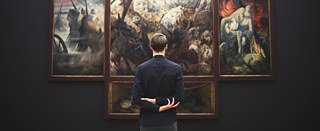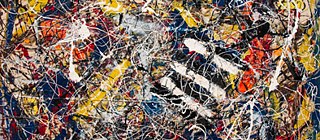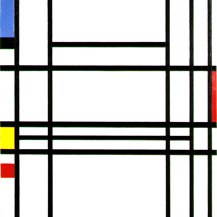The Elite in the Arts | Visual Arts
Abstract Painting in a Figurative World

A successful artist entering the twentieth century was more than likely a figurative artist, painting in a realistic style that is clearly derived from real objects. There was not much of a choice in the Western world, since the concept of what it meant to be an artist was ingrained institutionally within the educational and commercial institutes of the day.
Academicism, or academic art, was the foundation of the art world from the seventeenth to the twentieth century, and it was based upon universally-acknowledged skillsets established during the Renaissance. In fact, culture was so regimented that subject matter was narrowed to paintings of historical subjects, mythological stories, landscapes, and portraits. It was a language for the visual arts that was commonly understood in and outside the halls of elite arts institutions, making it universally popular.
The art world endured a number of significant shifts during the twentieth century, yet the advent of abstract painting was an enormous rupture that fractured how art was engaged in, studied and experienced. The industrial revolution of the eighteenth and nineteenth centuries set the stage for these changes as transportation, manufacturing, and technology were rapidly enhanced between 1760 and 1850. Transitioning from an agrarian to an industrial society prompted artists to rethink their daily lives and what kind of art they should create.


After the Second World War, the U.S. became the center of the art world. Abstract Expressionism (1940s - 1950s) was the dominant art movement in the art world, and Jackson Pollock was heralded as the quintessential artist of the time. His drip-style paintings put the final nail into the academic coffin, ushering in post-modernism and an identity crisis for the art world.
While Abstract Expressionism and Minimalism (1960s) further distanced art from consumption by the general public, the movement of Pop Art (1950s - 1970s) sought to turn the tables by showcasing objects and motifs of pop culture within the same elitist structures that removed painting more and more from the general public. Andy Warhol’s portraits of soup cans typify this concept of mass culture infiltration art with a capital “A”. As the twentieth century ended, the art world adjusted accordingly. Many of these narratives were broken and established a more pluralistic view of the art world, a view that has further blurred the lines between low art (works with mass appeal or utilitarian purpose) and high art forms (a vocabulary of the cultural elite, the wealthy and the educated). The story of the twentieth century painting can be summarized as classical connotations challenged, new definitions established, and two cultures eventually blended.
To the Overview